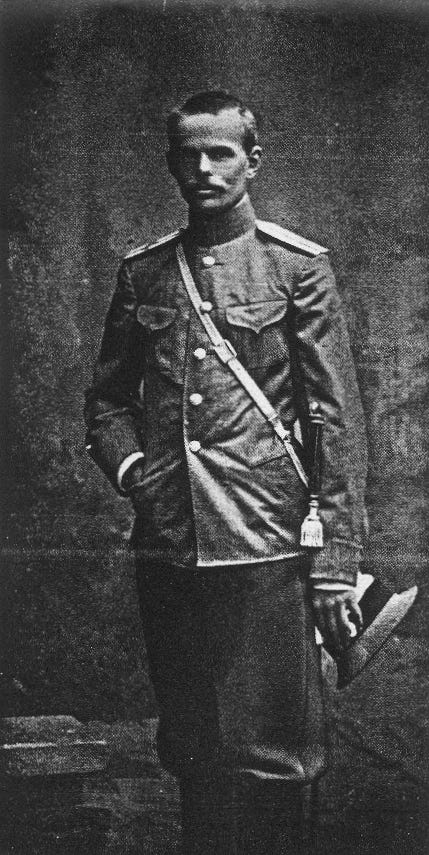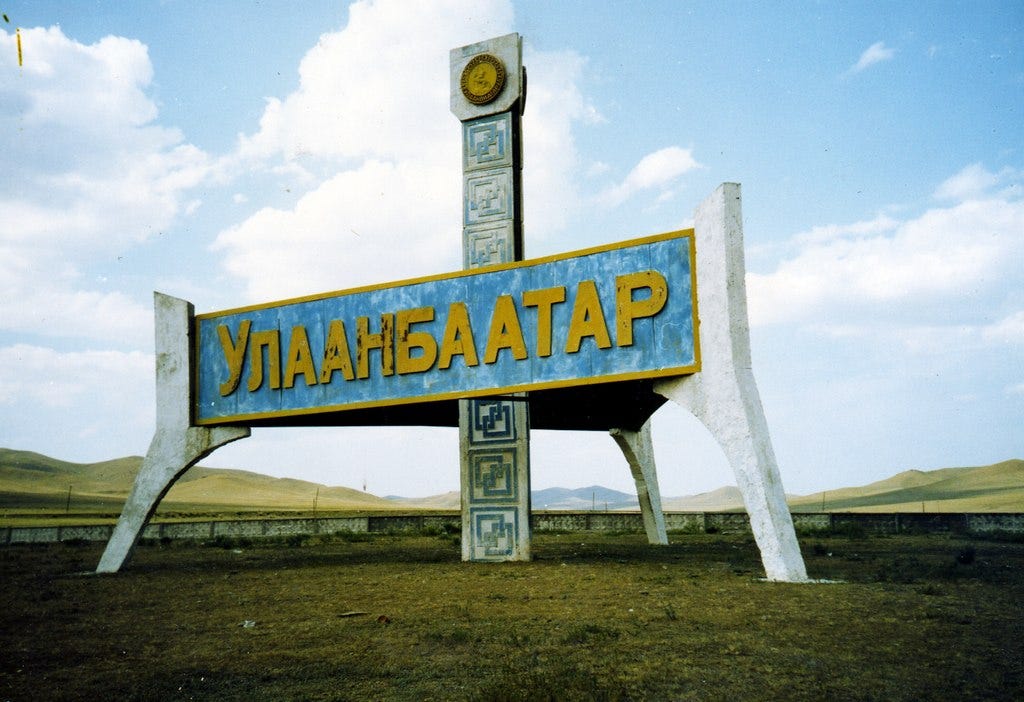The crazy story of Roman von Ungern-Sternberg—‘The Mad Baron’ of Mongolia
Imagine Mongolia in the early 1920s.
It’s so remote, nomadic families could spend an entire year without seeing more than a few dozen people. There’s no centralized currency. There’s no army except marauders and occupying Chinese troops.
The lone big city, Urga, is medieval-like but surprisingly cosmopolitan. European emigres and Chinese merchants rub shoulders with Buddhist priests and Mongolian natives. Mexican pesos, a popular trading currency at the time, is used as tender.
The country is also surrounded by war. There are Chinese warlords inside Mongolia and to the south. To the north, there’s a civil war between Russian communists and the counter-revolutionary Whites.
The craziest thing? A mad German noble named Roman von Ungern-Sternberg emerged out of this environment to build a nomadic army that sought to recreate the kingdom of Genghis Khan.
Today, Ungern is a largely forgotten figure from the era, having only partly re-emerged after the publication of James Palmer’s The Bloody White Baron, a 2008 biography of the warlord. Dressed in a yellow silk robe and riding a white horse—or dismounting and then skipping into battle—Ungern was in some respects the Russian civil war’s equivalent to Joseph Kony, the leader of the fanatical Lord’s Resistance Army.
Another comparison could be to the fictional Kurtz of Heart of Darkness and Apocalypse Now.
But he was real.
Like Kony, who fused elements of Christianity and Islam, Ungern combined eastern and western religious traditions into a syncretic, apocalyptic and messianic ideology. Like the fascist leaders that arose over the next two decades in Italy and Germany, Ungern espoused a violent anti-Semitism, anti-communism and anti-liberalism.
He enacted punishments of such cruelty it’s a wonder his men didn't revolt—though many deserted. He ordered whippings for minor infractions. Soldiers caught drinking alcohol would be stripped naked and ordered to spend the night on a frozen river. This left them vulnerable to being attacked and eaten by wolves.
His sadism wasn't unusual for an officer schooled in the Tsarist tradition. Conscripts in the imperial armies were treated no better than slaves and could be killed by their own officers. If captured, Red Army soldiers could expect to be buried alive or crucified.
But Ungern found inspiration in depictions of torture found in Mongolian Buddhist monasteries and popular literature. “All of Ungern’s favorite tortures were prominent in the hell scrolls of the Mongolian monasteries: exposure on the ice, burning alive, rending by wild beasts,” Palmer wrote.

The mad baron
Where the Hell did this guy come from?
Ungern was born in 1885 to a Baltic-German noble family. He was born in Austria but moved to Estonia early in life, where his family pledged fealty to the Tsar.
He also came of age during the turn of the century, when traditional feudal systems in Eastern Europe were under increasing threat. Revolutionary movements were growing in support, and his family’s privileges were at risk.
At the same time, there was a budding, faddish attraction among European elites to New Age beliefs, Eastern mysticism and occultist practices. Ungern was enamored with some of these beliefs, and combined them with anti-Semitism and faith in monarchical rule.
Ungern distinguished himself as a cavalry officer during the First World War, fighting against both Germany and Turkey. He also served in Cossack units and had a reputation for being a violent, drunken lunatic. He was thrown in a military prison for two months after slashing a military commandant’s aide across the head with his cavalry sword.
He became something of a shadowy figure during the early years of the Bolshevik revolution. His locations are hard to pin down or merely rumors.
But after the collapse of the Tsarist regime in 1917, he re-emerged among the scattered counter-revolutionary White forces based in the far east. Eventually, he became governor of the eastern province of White-ruled Transbaikal.
Ungern’s forces were a bit of an oddity. They operated independently from Adm. Alexander Kolchak, the most prominent White officer in Russia’s far east. Ungern’s troops were instead backed by Japan.
The areas involved in this war were vast. Entire battalions could move through enemy lines without being detected. But strategic locations, particularly railway hubs, were few and bitterly contested.
By August 1920, the White forces were badly losing the war. Kolchak had been defeated and executed. The hope of restoring the Tsar to the throne was dashed after Nicholas II’s execution in 1918. To further drive the nail into the monarchy’s coffin, the Tsar’s youngest son, the Grand Duke Michael, was shot.
Ungern was on the run. But his forces were highly mobile, sustaining themselves by living off the land or through piratical raids. They forcibly conscripted new soldiers into their ranks and wore tattered uniforms made from animal skins.
An opportunity presented itself in Mongolia. The Bogd Khan (the resident monarch) sought an alliance with Ungern to drive out occupying Chinese forces. For Ungern, shifting his forces into Mongolia served both practical and ideological needs.
They could recruit or conscript new soldiers—but also fulfill a new purpose.
Palmer explained:
[Ungern] had striven to save the empire he had been raised in, but it was almost irretrievably corrupted. Russia’s core had been lost to the Bolsheviks. A new empire would have to be created, and he had the model for it in the empire of Genghis Khan, which had once stretched ‘from the Amur Mountains to the Caspian Sea.’ Ungern did not believe himself, as some later claimed, to be the reincarnation of Genghis Khan; instead he saw himself as restoring his legacy.
His army also marched under a diverse set of banners reflecting the hodge-podge of Ungern’s beliefs.
One banner included the symbol of the Grand Duke Michael represented as the new Russian emperor. Another banner included an image of Jesus Christ with a yellow background, symbolizing Buddhism. Another banner featured the swastika.
“This was, of course, an old and valued Buddhist motif, but Ungern would also have been aware of its anti-Semitic interpretation, as would most of the Whites,” Palmer wrote.

The battle for Mongolia’s capital
Until Ungern’s capture and execution in 1921, his troops engaged in scattered battles with numerically larger Chinese forces. At the same time, a bizarre cult emerged among Buddhist lamas loyal to Ungern or his Mongolian allies.
“There was no official Mongolian recognition of Ungern as an incarnate god, despite all the other titles heaped on him,” Palmer cautioned. “The belief probably sprang up spontaneously: a mysterious figure from the north, riding a white horse, ignoring bullets and claiming to fulfill ancient prophecies—it was only logical to think him a god.”
At the peak of his power—which wasn’t much—his forces numbered between 5,000 and 6,000 troops. About half of them were Mongolians, with others from Russia, Japan, China and Central Asia. (Russians made up the largest non-Mongolian contingent.) They used Japanese rifles, Italian machine guns—extending to pikes and lances.
The largest battles fought during this period centered around Urga, today the modern Mongolian capital of Ulaanbaatar.
The city had been walled by heavily-armed Chinese troops, but the soldiers were demoralized and poorly trained. In October 1920, several attacks by Ungern’s troops were repulsed by Chinese artillery.
The following February, Ungern’s forces were freezing and running out of food. His men reconnoitered an unguarded gate and launched a surprise assault. Tibetan monks serving with Ungern’s force joined the push, “their clothes lightly smeared with butter and their faces painted with soot to strike fear into enemies of the faith.”
The horseback soldiers stormed into the city, which descended into house-to-house fighting.
“Once the gates were breached, the fighting turned into a general killing spree,” Palmer wrote. The Chinese troops abandoned the city. Many were later hunted down and slain in the countryside.
What befell the city’s inhabitants was sickeningly brutal and ugly—including indiscriminate attacks on Jews, Russian emigres and Chinese residents. Victims were strung up along city streets. One Russian soldier serving in Ungern’s forces had a reputation for killing the elderly with his hands.
But Ungern’s terrible reign would only last a few months.
At this point, he was the last prominent White commander still on the loose. The capture of Urga shocked the Kremlin, which proceeded to invade Mongolia. The Red Army splintered Ungern’s forces, and he was captured in August 1921, put on trial and shot by firing squad.
He was 35.
Since his death, his legacy has been largely confined as a footnote to the horrors that would later inflict Europe during the Holocaust and the Second World War. “In the murky world of post-war rightist occultism he was remembered as a precursor figure of the weirder fringes of Nazism,” Palmer wrote.
Accounts of his brief reign would filter back into Germany, which provided inspiration to some extreme nationalists and lurid pulp books. Today, he’s still celebrated on neo-Nazi Websites.
But he was also a precursor to sinister, rebel cults operating today. He moved around in remote, ungoverned spaces and forged a reputation for cruelty. He was highly maneuverable and his forces operated over vast, wild areas.
But once a committed force was tasked with hunting him down, his days were numbered. He wasn’t impossible to stop.

No comments:
Post a Comment